General contractors (GCs) have no shortage of tools when it comes to finding and managing subcontractors. Two options often considered are The Bluebook Building & Construction Network (often simply called Bluebook) and Downtobid’s Network. Bluebook is a long-standing industry directory, while Downtobid is a newer platform geared toward streamlining preconstruction bidding.
This comparison will explore how each network stacks up in key areas: subcontractor database quality and verification, coverage and reach, search and matching capabilities, integration with the invitation to bid (ITB) process, ease of use, and overall pros and cons. By the end, you'll have a clearer idea which network is better suited for your needs as a GC building strong subcontractor relationships.
Note: Leverage Downtobid's mulitverification network for updated contacts for subs in different cities around the nation. Simply upload your project plans, and you can send personalized bid invites in minutes to verified contractors. Click here to try our software for free.
Key Takeaways
- Sub picking is key—Downtobid beats Bluebook with verified subs and smart automation.
- Downtobid’s 57k fresh profiles and AI matching outpace Bluebook’s vast but stale data.
- Bluebook wins on size; Downtobid nails ease, updates, and outreach with 30% more responses.
- Downtobid’s planroom and follow-ups save time; Bluebook lags without active engagement.
- Try Downtobid’s demo now to streamline subs and win more—automation power awaits.
What is Downtobid's Network?
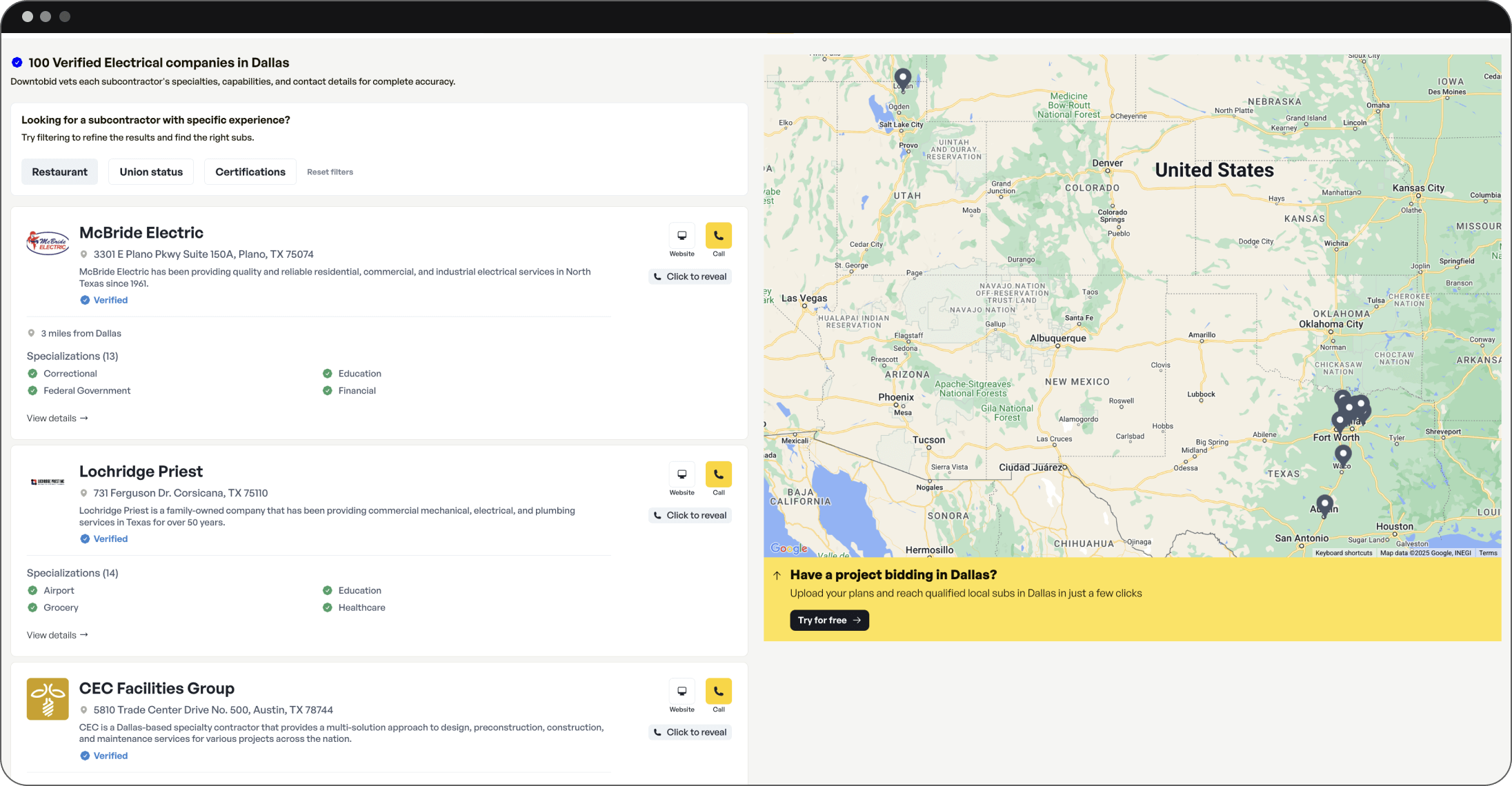
Downtobid’s Network is an online platform that connects general contractors (GCs) with a pre-vetted database of qualified local subcontractors. It was designed to streamline how GCs find and invite subs to bid. The platform actively verifies subcontractors’ credentials – checking licenses, insurance, certifications, and even past performance – before including them in the network.
Downtobid continuously updates and cleans its subcontractor list: the team follows up with subs to refresh availability and contact info, and an AI-driven system removes inactive or unresponsive subcontractors to keep data fresh. As a result, GCs using Downtobid are unlikely to encounter outdated phone numbers or dead-end emails in the contact list.
What is The Blue Book Network?
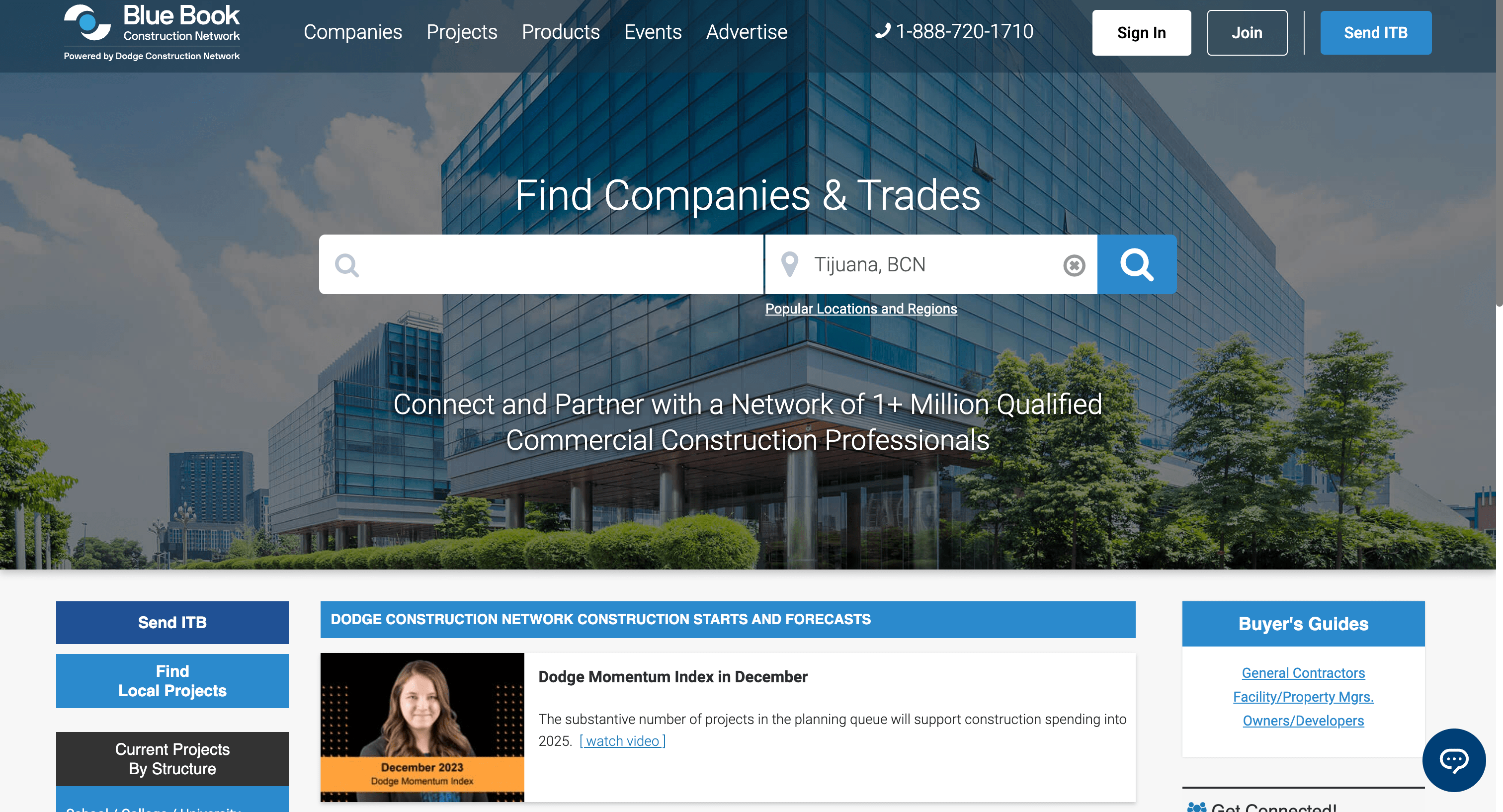
The Blue Book Building & Construction Network (often simply called “Blue Book”) is a long-established industry directory of contractors, subcontractors, and suppliers like the Dodge Consrtuction Network. It has served the commercial construction industry for many years as a go-to source for finding construction professionals.
The Blue Book originally existed as a printed directory and has since evolved into a digital platform. Its credibility comes from its longevity and widespread use – most construction companies in the U.S. are aware of The Blue Book, and many maintain a listing there. In fact, Blue Book advertises itself as “the largest network of construction professionals across all specialties and trades,” making it a comprehensive starting point for finding just about any trade partner.
Key Features of Downtobid’s Network
Downtobid is more than just a list – it’s a platform with built-in technology and processes to make finding and working with subs easier. Here are some of its core features:
- Pre-Verified Subcontractors: Every subcontractor in Downtobid’s network is pre-screened for quality and compliance. The Downtobid team verifies important documents like licenses, insurance certificates, and any relevant trade certifications. They also look at the subcontractor’s track record (performance history) to ensure it aligns with what the sub claims to do. Finding reliable and verified subcontractors is simple. This vetting gives GCs more confidence that a “Downtobid sub” is legitimate and capable. Moreover, Downtobid's software maintains a “live” subcontractor database – they actively update each subcontractor’s status. If a subcontractor’s contact information or availability changes, Downtobid works to update it.
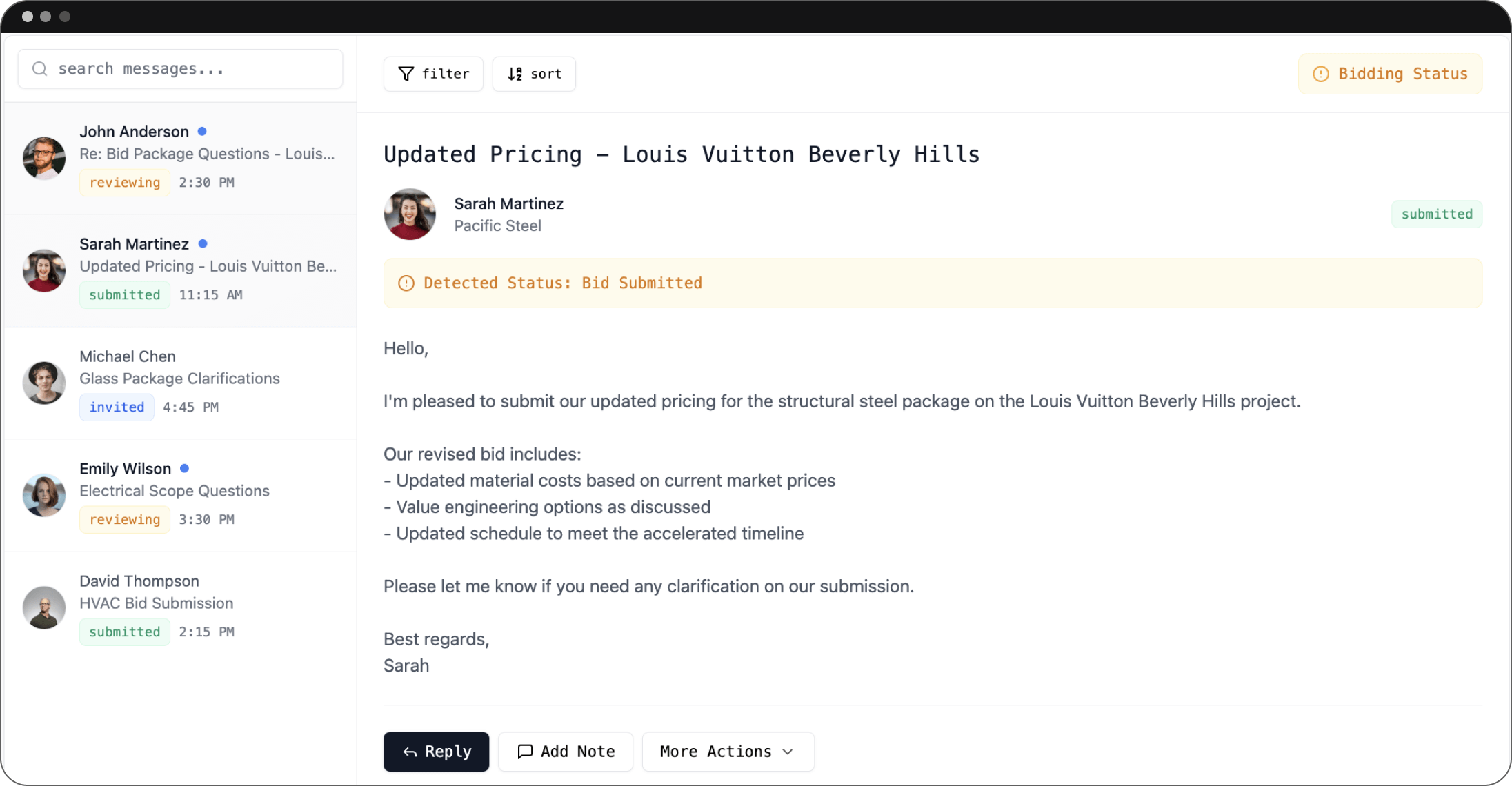
- AI-Powered Matching: Downtobid’s standout feature is its use of artificial intelligence to interpret project information and match the right subs to the job. The AI looks at subs’ past project types, specialties, and location coverage to recommend those that are most likely to be a good fit –It’s like having a personal assistant scan your project and pull up a shortlist of qualified subs for each division of work. GCs can, of course, adjust or add their own preferred subs, but the heavy lifting of building an initial bid list is handled by the algorithm. This targeted matching ensures you’re not blasting your invitation to bid to random companies – you’re reaching subs with the right experience in the right area.
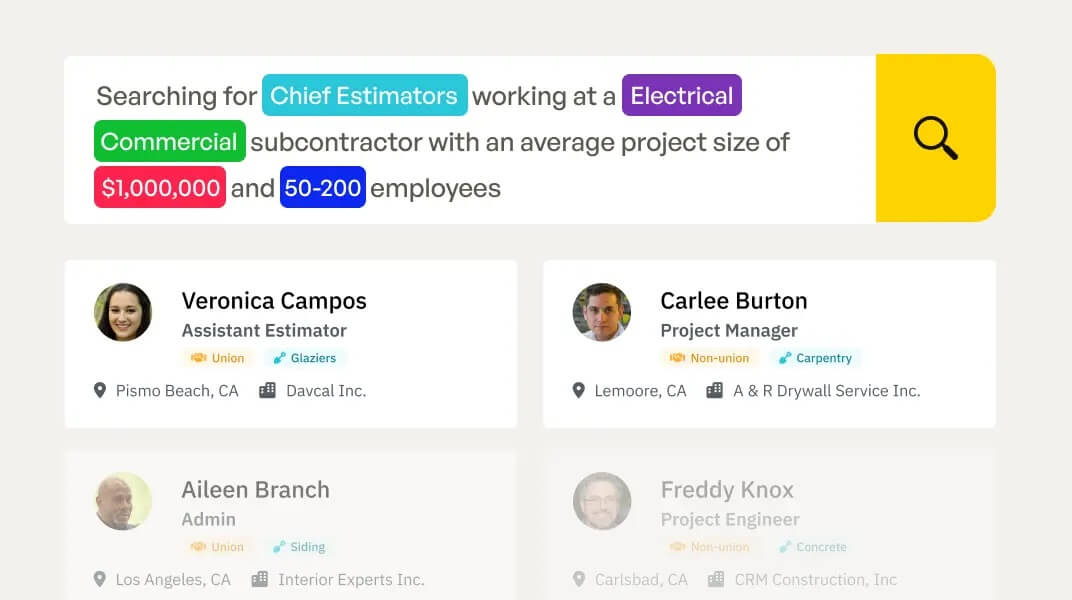
- AI Assisted ITBs: Once you have the list of subs for each scope, Downtobid helps you contact them in a streamlined way. The platform can send out personalized Invitations to Bid (ITBs) to all selected subcontractors at once. These invitations aren’t generic mass emails; they include the specific project details and are tailored to each trade, and they come directly through the Downtobid system (which subs can recognize, especially if they’ve used the platform) Downtobid’s invites have built-in response options and tracking – subs can respond via email and the AI will categorize responses into confirmations, declines, etc.
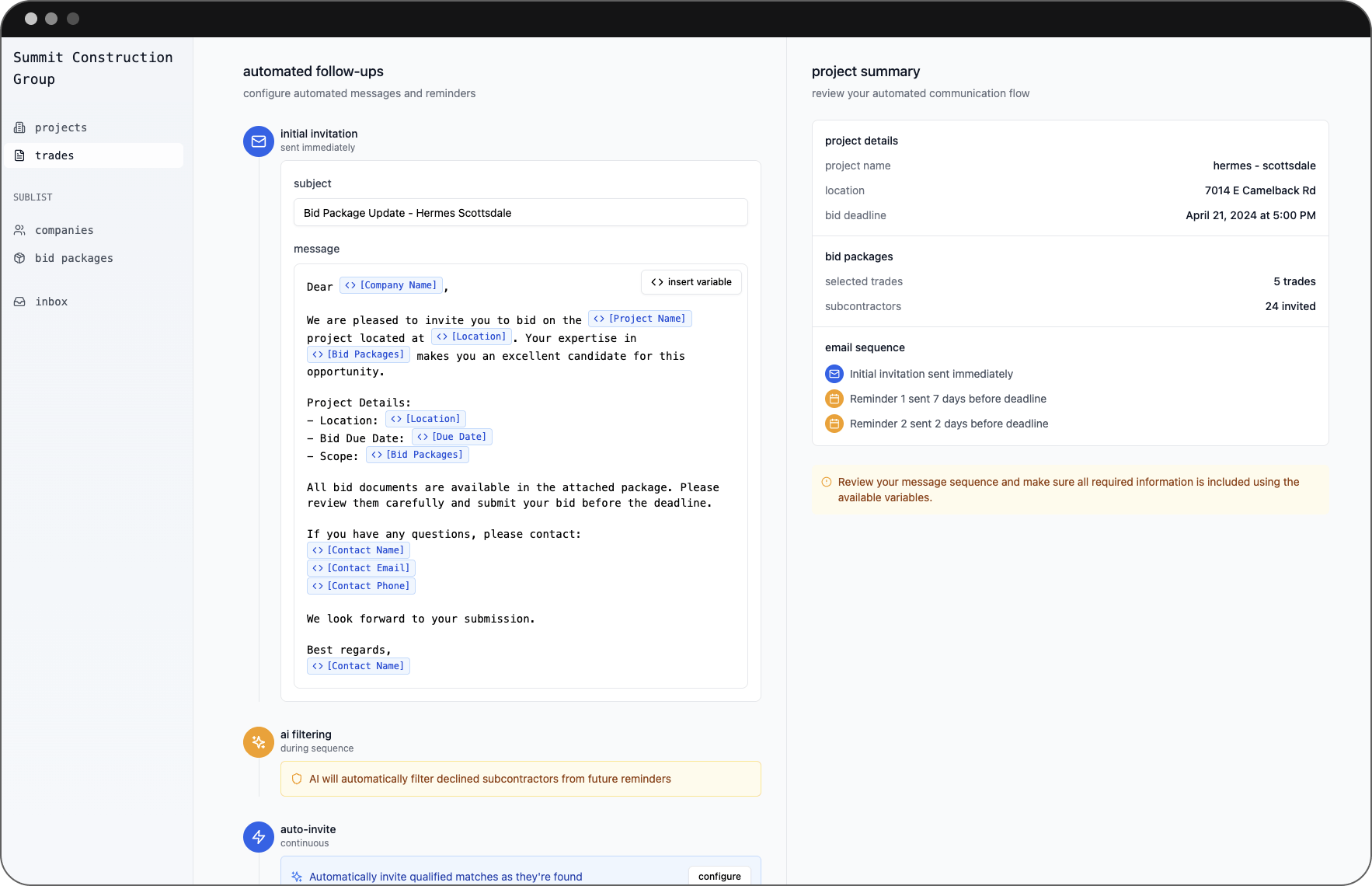
- Automated Follow ups: Crucially, Downtobid also offers automated follow-ups. For example, if a subcontractor hasn’t responded to the invite after a certain time, the system can send a polite reminder or follow-up message automatically. This kind of nudge often doubles the response rate compared to a one-and-done email blast. By ensuring the invite doesn’t get lost in a spam folder or forgotten, Downtobid helps GCs get more subs engaged.
Key Features of The Blue Book Network
The Blue Book Network, while more traditional, offers its own set of features aimed at helping GCs find and manage subcontractors. Here are the notable features and tools associated with Blue Book:
- Extensive Subcontractor Directory: The Blue Book’s biggest asset is its breadth of listings. It has an extensive directory of subcontractors, contractors, and suppliers across 560+ trade categories and all regions of the U.S. Through the Blue Book website, a GC can search for companies by trade (e.g., masonry, electrical, landscaping) and by location or radius. The search can be refined with keywords to pinpoint specific services (for example, searching “solar panel installation” within electrical contractors). It’s especially useful as a starting point – GCs often use it to generate an initial list of local firms to consider.
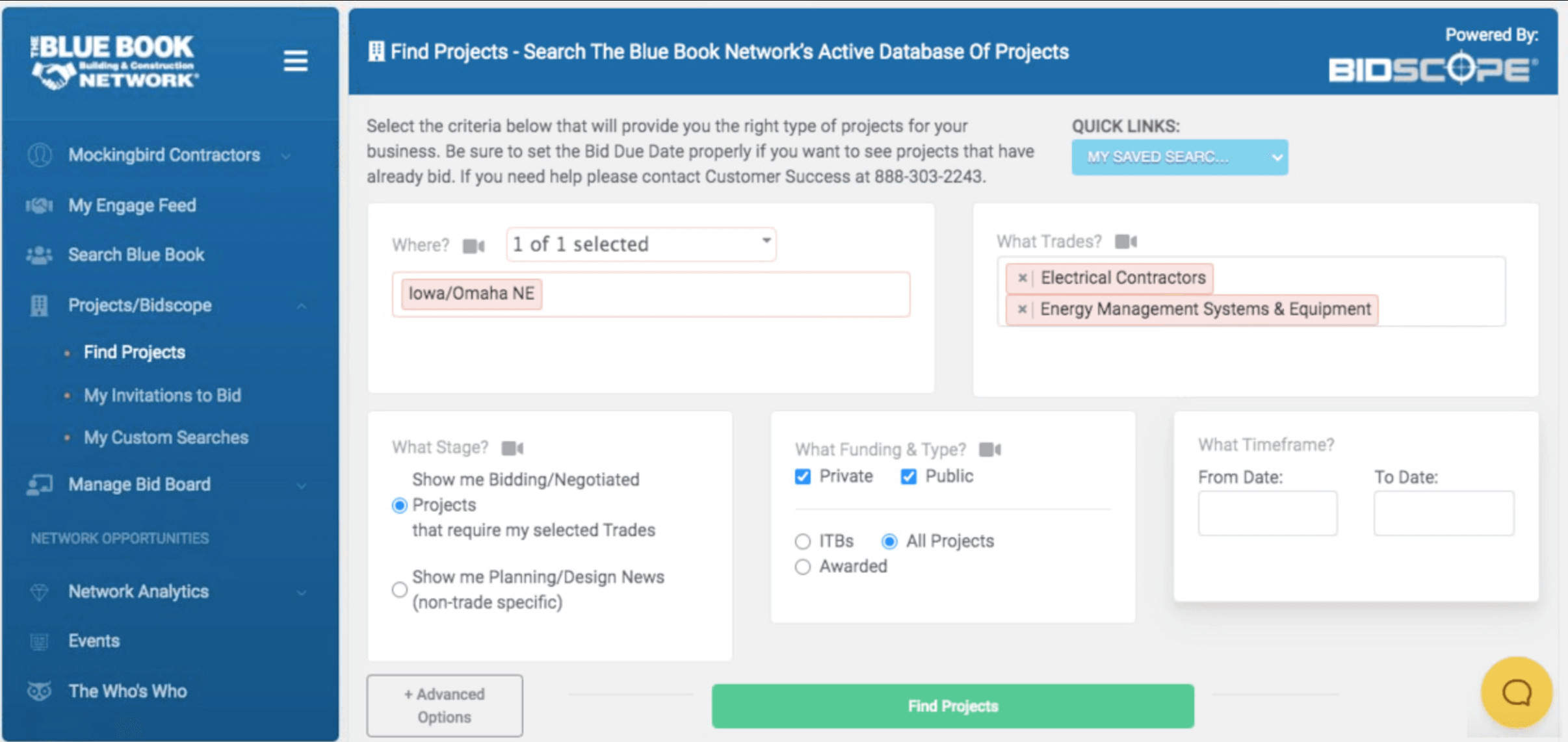
- Subcontractor Profiles (ProView): Each subcontractor or vendor in Blue Book can maintain a profile page known as a ProView. On a ProView profile, GCs might find information like the subcontractor’s specialties, regions served, project portfolio, references or client testimonials, and even upload photos of past projects. However, the amount of detail on a profile can vary depending on the subcontractor’s engagement with Blue Book. Companies that pay for a premium Blue Book membership tend to have more fleshed-out profiles – including things like project case studies, detailed service descriptions, and sometimes client reviews or ratings, plus verified info like insurance and bonding capacity
- Customizable Watchlists: For organizational purposes, Blue Book lets users create watchlists or lists of favorite contractors. As a GC, you might browse the directory and flag 10 concrete contractors that look promising. You can add them to a watchlist named “Concrete Subs” (for example) and similarly build lists for other trades like “Roofing Bidders” or group them by project or division.
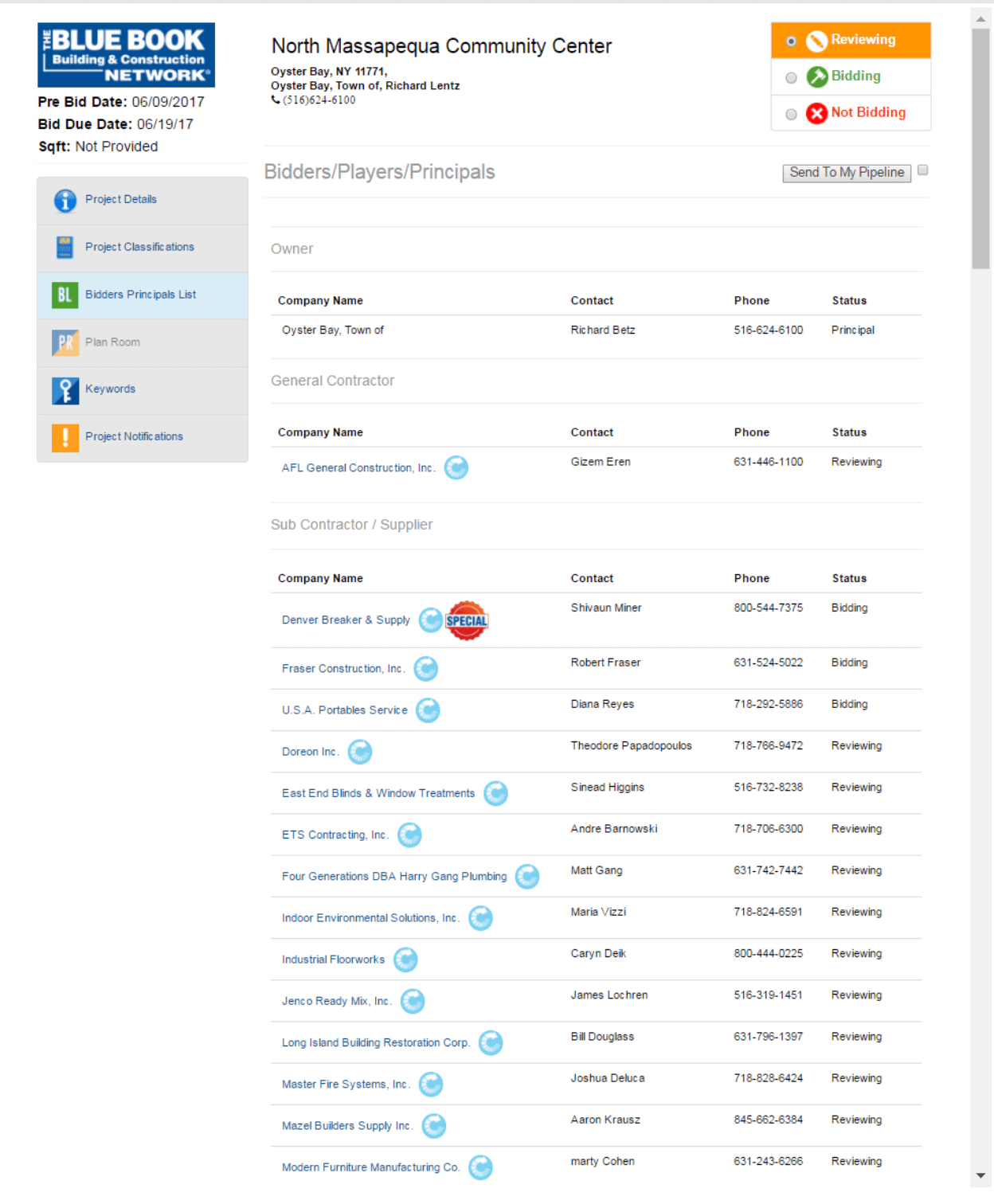
- Bid Invitation and Engagement Tools: While Blue Book started as just a directory, it has added bid management tools over time (especially after partnering with or being acquired by Dodge). One key tool is OneTeam®, Blue Book’s online bid management portal for GCs. OneTeam is essentially a private hub where a GC can manage a project’s bidding process: you can assemble a list of subs, send out invitations to bid, share plans and specs, and communicate – all within the OneTeam interface. Learn more here.
Head-to-Head Comparison
Now that we’ve outlined what each platform offers, let’s compare Downtobid’s Network and The Blue Book Network on key factors that matter to general contractors. We’ll look at aspects like the size and accuracy of their subcontractor pools, how easy it is to find and engage subs, how fresh the data is, the methods of outreach available, and overall value. For each category, we’ll declare which platform has the edge.
Network Size
Blue Book: The Blue Book has a clear advantage in raw size of the network, accumulated over many decades. In practically any U.S. city or region, Blue Book will list more subcontractors (in total) than newer platforms. However, that massive size is a double-edged sword when it comes to accuracy. Not all listings are up-to-date or relevant. Blue Book’s data can be hit-or-miss – some entries are gold (active, responsive subs), while others might lead you to wrong numbers or companies no longer seeking work.
There’s minimal ongoing verification beyond the initial listing. So, while you get quantity, you might sacrifice quality. GCs often find that they need to vet and filter Blue Book results heavily to identify which subs are actually viable.
Downtobid: Downtobid’s network is smaller in absolute numbers (currently about 57,000+ active subcontractor profiles nationwide. However, Downtobid focuses on curation and accuracy of that network. Every one of those 57k profiles is supposed to be active, verified, and relevant. So while you may have fewer total names in Downtobid for a given trade/area compared to Blue Book, those you do find are far more likely to be accurate contacts and qualified companies.
Winner (Network Size): Blue Book – it simply has more subcontractors listed overall, given its decades-long head start and broad inclusion policy. If you need to cast the widest net possible, Blue Book provides the volume.
Winner (Data Accuracy): Downtobid – by a wide margin. Downtobid’s insistence on verifying and updating subcontractor info means its network quality is higher and more reliable.
Ease of Finding & Engaging Subs
This category looks at how easy it is for a GC to identify the subs they need and get those subs engaged in bidding.
Blue Book: Using Blue Book to find subs is straightforward in concept – you use the search filters and get a list of companies. However, the ease of finding the right subs can be challenging. The search results can be very broad, and some users note that the website’s interface for narrowing down results isn’t the most user-friendly.
Many GCs using Blue Book end up performing a lot of manual outreach – sending individual emails or using mail-merge – and then following up with phone calls. In general, GCs report that simply sending an unsolicited ITB (Invitation to Bid) email via a directory often isn’t enough; you still have to pick up the phone.
One estimator on Reddit noted that regardless of what system you use, you’ll likely need to call about 80% of the subs to get firm answers – often they haven’t even opened the email invite (what bid invite software do you use? : r/estimators).
Downtobid: Downtobid was explicitly designed to make finding and engaging subs as easy as possible. The process of finding subs is largely automated by the AI: you don’t have to manually search at all – the system suggests subs based on your project documents. As for engaging subs, Downtobid shines by integrating the invitation and follow-up process into one platform. You can send out all your bid invites in a batch, but each is personalized, and the subs can respond through Downtobid’s interface.
The platform then tracks who replied “yes, will bid” or “no” or hasn’t responded yet. Crucially, Downtobid automates follow-ups to those who haven’t responded, which is something a GC would otherwise do by phone or additional emails. This dramatically increases the ease of engagement – instead of the GC making 20 phone calls to chase responses, the system is nudging subs and only truly requires manual intervention for the stragglers.
Winner (Ease of Finding & Engaging): Downtobid. Downtobid clearly wins here because it minimizes the work a GC has to do to identify the right subs and proactively engages them on the GC’s behalf. Blue Book can provide you a large pool to search through, but you have to do the searching and courting.
Frequency of Data Updates
Blue Book: The Blue Book Network does not have a strong mechanism to frequently update subcontractor data across the board. Subcontractors are responsible for updating their own profiles (especially if they want to showcase new projects or capabilities), and Blue Book sales reps might prompt updates during membership renewal discussions.
But if a sub isn’t actively managing their profile, it can sit unchanged for a long time. Some subs treat Blue Book as a static phone directory listing – once their contact info is up, they might rarely log in to update anything. As a result, the frequency of updates is inconsistent.
Downtobid: Downtobid was built with data freshness as a priority. It employs a multi-verification process on an ongoing basis.This means Downtobid doesn’t just vet a subcontractor once and forget about them; the platform continuously monitors and updates its subcontractor records. Through both automated means (AI) and direct follow-up,
Downtobid keeps tabs on whether a subcontractor is still active, whether their contact information has changed, and whether they are currently looking for work. They likely reach out to those subs to confirm details or remove them if they can’t be reached. When Downtobid says “57,000+ active profiles,” active is the key word – the list is actively maintained.
Winner (Data Updates): Downtobid. There’s no contest on this front. Downtobid’s model is predicated on continuously updated, verified data, whereas Blue Book’s model is more static and user-maintained.
Contact Methods & Outreach Automation
Blue Book: When it comes to contacting subs and sending out bid requests, Blue Book mostly serves as an information source rather than an interactive communication platform (unless you use their premium tools). The traditional method with Blue Book is: find subs, then contact them via phone or email outside of the system.
Blue Book itself doesn’t automatically send any emails on your behalf unless you use OneTeam or Concierge. With the OneTeam bid management suite, a GC can compose an ITB and send it through the platform as a mass email (each sub gets a personalized invite link). That is helpful, but essentially it’s an email blast with a link to project documents – similar to other bid invite software. It’s worth noting that many subcontractors receive Blue Book invites or similar mass invites regularly, and these can sometimes be perceived as spam if they don’t recognize the GC.
Downtobid: Downtobid was built with outreach automation at its core. As described earlier, the platform can automatically send out personalized invitations to bid to all relevant subs with one action. But it doesn’t stop at sending – it actively manages the communication flow. It will send reminders to subs who haven’t responded, and it can even escalate outreach if needed (for example, possibly notifying Downtobid staff to call a sub if the GC really needs that trade filled – though the specifics of that aren’t public, the platform emphasizes ensuring responses).
Downtobid essentially turns what is normally a manual, repetitive task (emailing, waiting, emailing again, calling) into an automated sequence. From a GC’s perspective, this is invaluable. You set up the invites, and then the system does the polite pestering for you. The invites themselves are more likely to get attention because they include the sub’s name and relevant project info right in the message (as opposed to a generic blast)
Winner (Outreach & Automation): Downtobid. When comparing the two, Downtobid clearly has the superior and more modern approach to outreach. It automates what Blue Book leaves manual. For a GC, that means less time chasing and more consistent contact with subs. Blue Book’s tools can send an email blast, but Downtobid’s platform will essentially manage the follow-up conversation. Unless a GC is prepared to personally call every non-responsive sub (which is often the case with Blue Book), Downtobid’s method provides far more value in this category.
Overall Value
“Overall value” considers what you get out of each platform relative to the effort or cost. This includes intangible benefits (time saved, risk reduced) and, if applicable, monetary cost of using the service.
Blue Book: On the plus side, Blue Book can be used in a basic way for free by GCs. Simply searching the directory costs nothing, and even using the OneTeam invitation tool might be included in some project lead services (depending on if the GC or their company has any Dodge subscriptions). So for a GC on a budget, Blue Book offers a lot of information at no direct cost – it’s essentially a free lead list.
However, the true cost of Blue Book is in the time and uncertainty. The hours an estimating team spends scouring listings, making calls, and following up on emails could be seen as an indirect cost. If using Blue Book yields only a few responses and you have to supplement with Google searches or other methods (as some GCs report doing), then its value diminishes. We do a complete breakdown of the pricing of Blue Book here.
Downtobid: Downtobid’s value proposition is largely in the time and effort it saves, and the increased bid coverage it can generate. Time saved is money saved – if an estimator can manage more projects or focus on higher-value tasks instead of data entry and follow-ups, that’s a tangible gain. Downtobid users have reported significant improvements in their bidding efficiency – for example, getting 30% more responses from subs and being able to assemble bids much faster than before.
Winner (Overall Value): Downtobid. It delivers tangible savings in time and improved effectiveness (more responses, better coverage), which ultimately can help GCs win more projects and reduce overhead.
How To Use The Downtobid Network: Subcontractor Database
Here are step-by-step instructions for using the Downtobid Network directory to find subcontractors.
First, navigate to the Downtobid contractor search page by visiting this Search link.
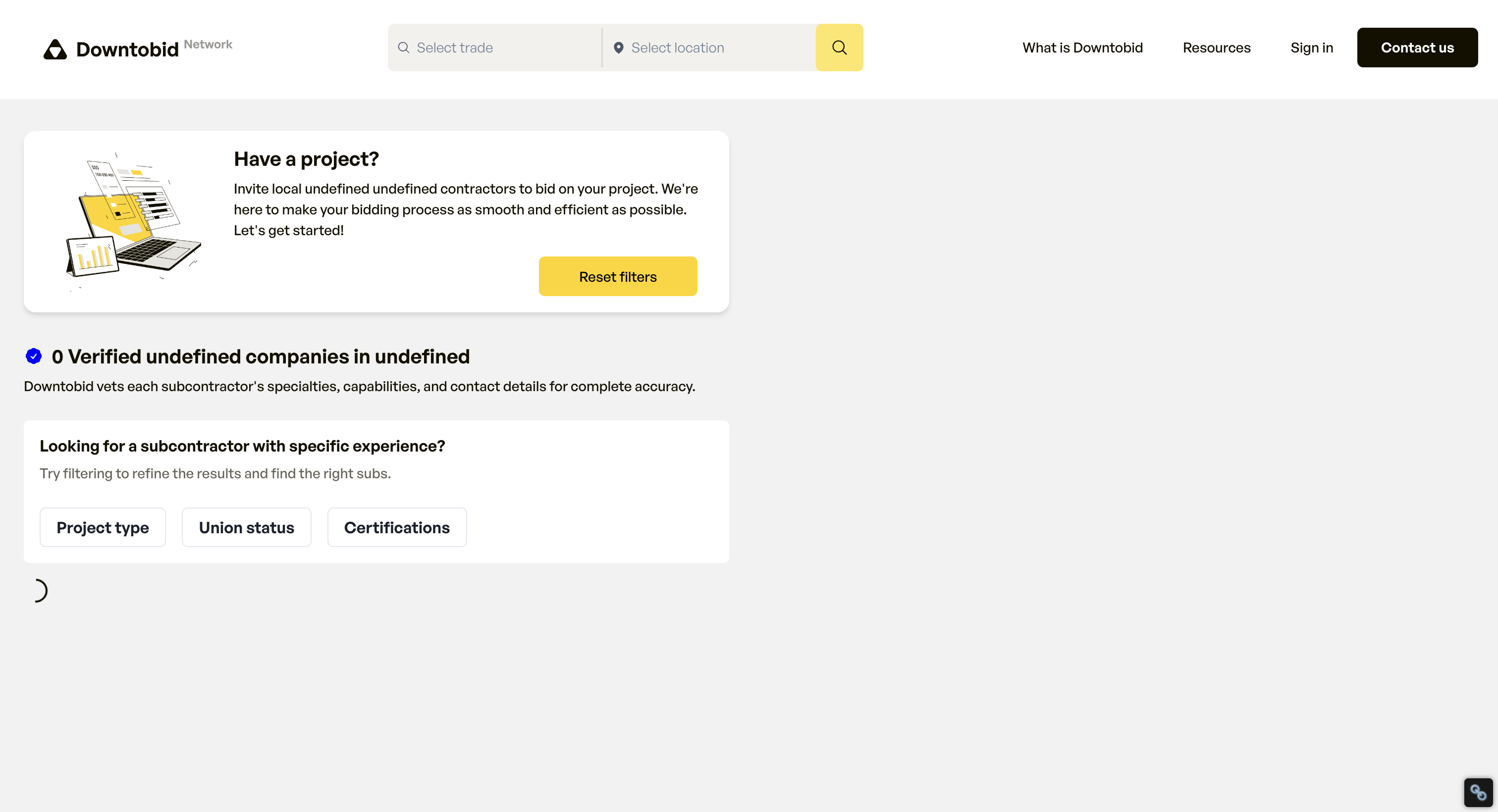
Locate the fields labeled for ‘Trade’ and ‘City’. Here, type in the specific trade you’re looking for, such as “electrical”, and the city where your project is located, like “Houston”. The system will then retrieve a list of subcontractors that match the trade and location you specified. The results are organized to provide a quick overview of each potential subcontractor.
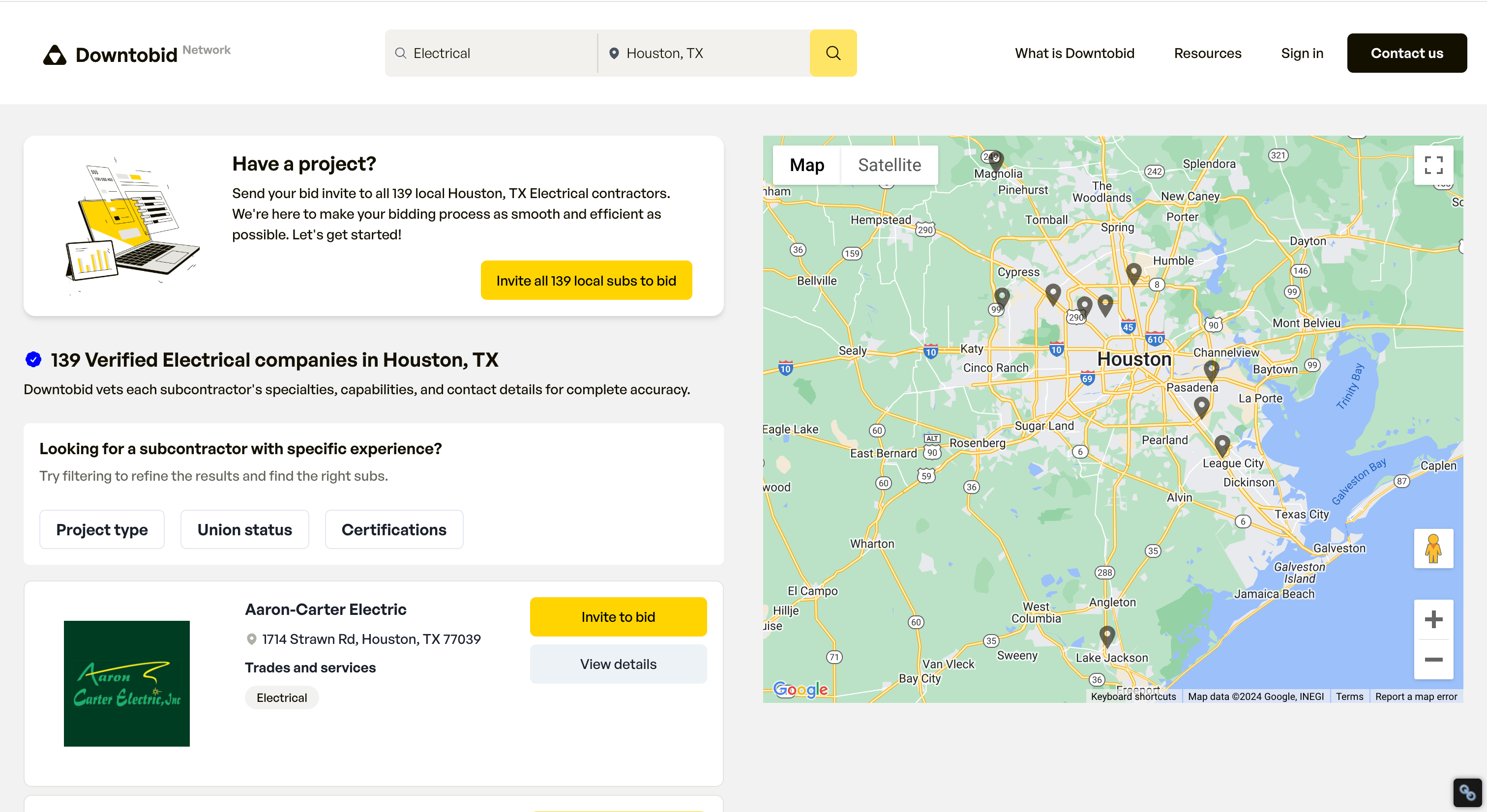
In the search results, each subcontractor’s entry includes a brief preview of their profile. You can click on the subcontractor’s name or the ‘Details’ button associated with their listing to access a full profile. This profile contains extensive information including their contact details, qualifications, and past project experiences, allowing you to decide better.
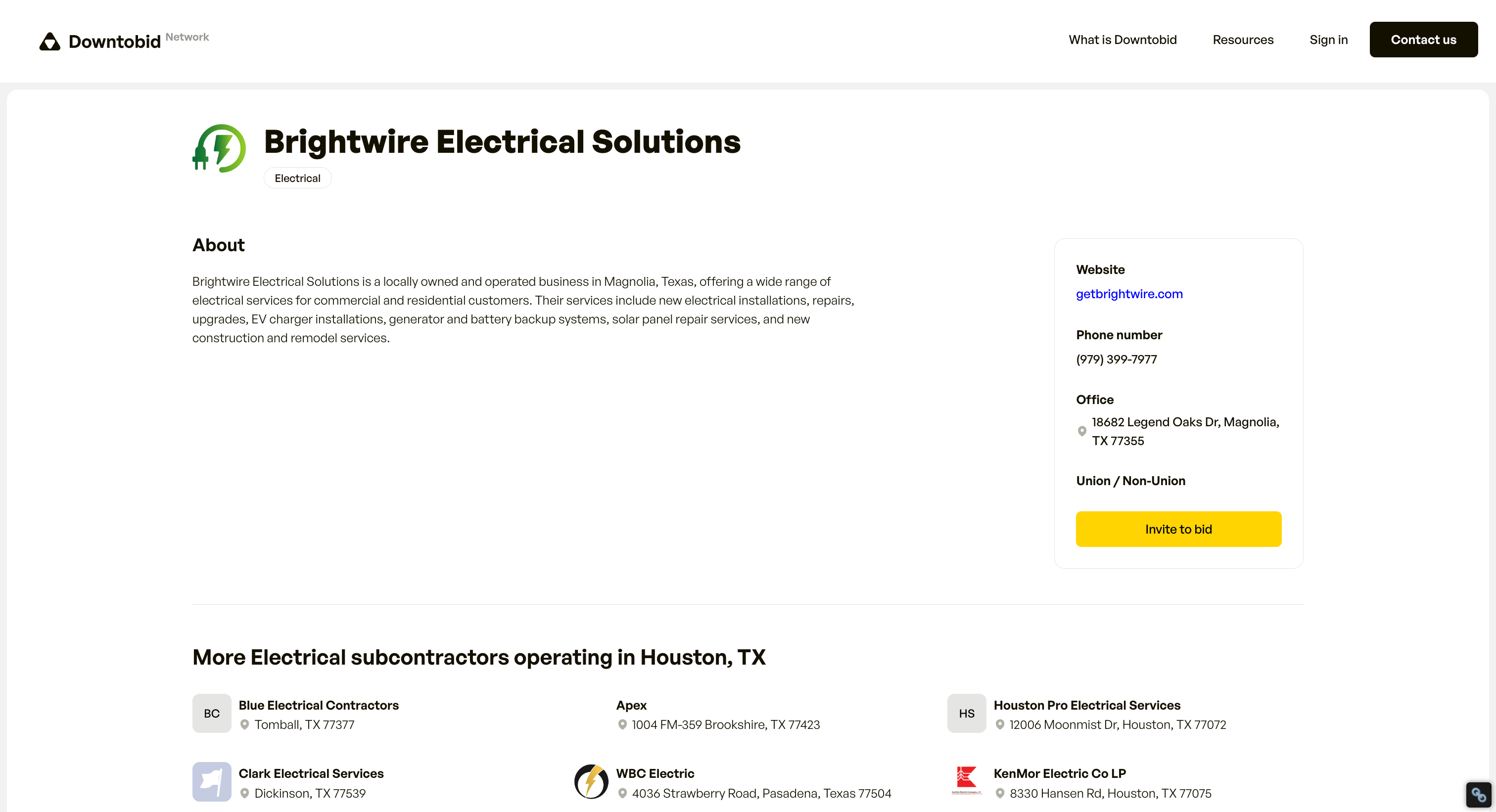
You can also click "Invite to Bid" where you will be redirected to a page to upload your project plans. We'll go over how to do that in the next section.
How to Use Downtobid To Invite Relevant Subs In Minutes
Downtobid is a straightforward platform to use. We created the software after chatting with hundreds of contractors complaining about basic platforms with outdated subcontractor databases. We developed a platform that selects only the most qualified local subs. Here’s how you can use our platform to automatically invite subs by uploading project plans.
Click here to get sign up for a demo. Once you place your details, someone on our team will reach out you to create a project.
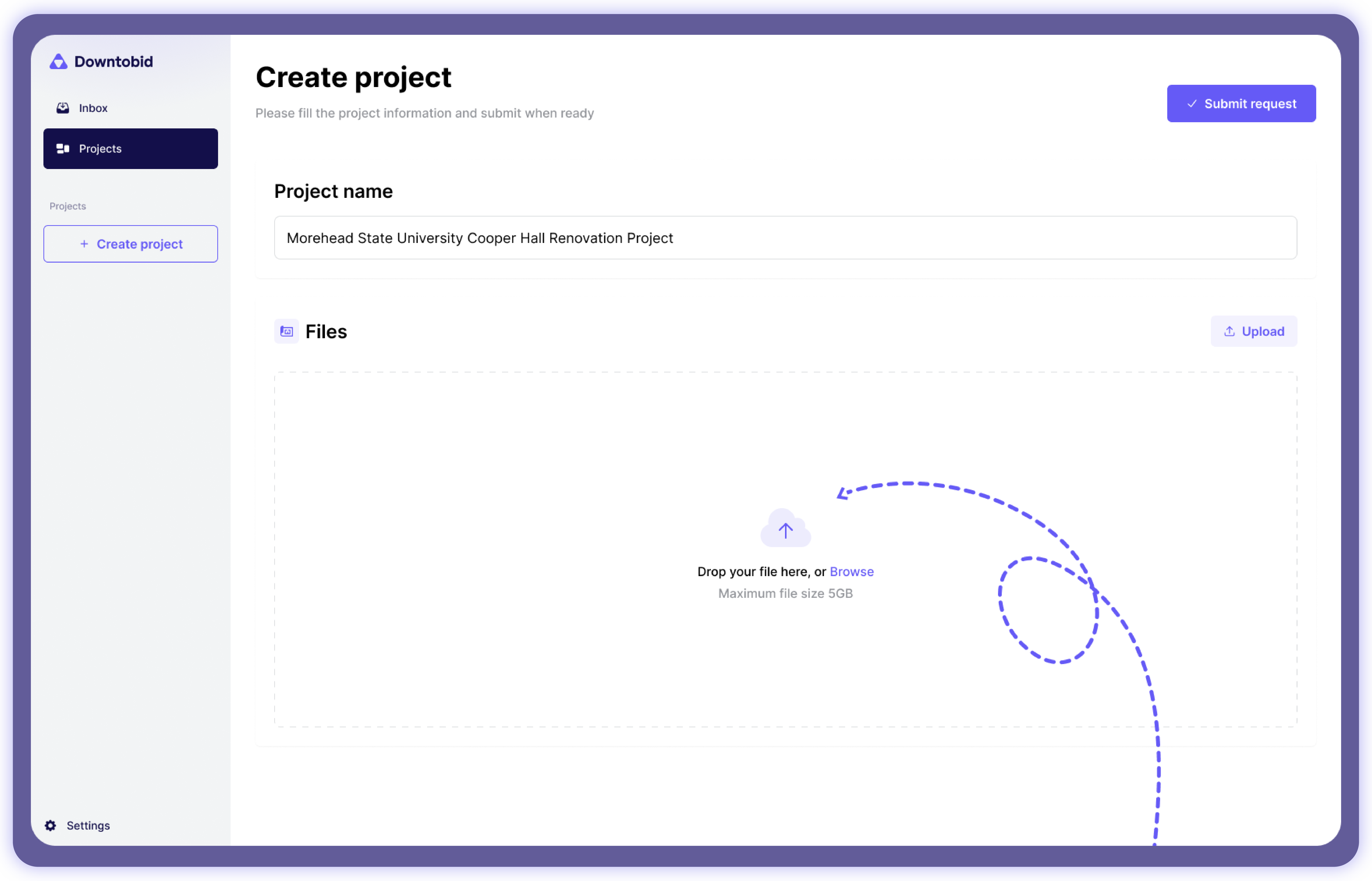
Start by uploading the construction plans, which must be in PDF format and not exceed 1GB. Enter a valid email address and create the project.
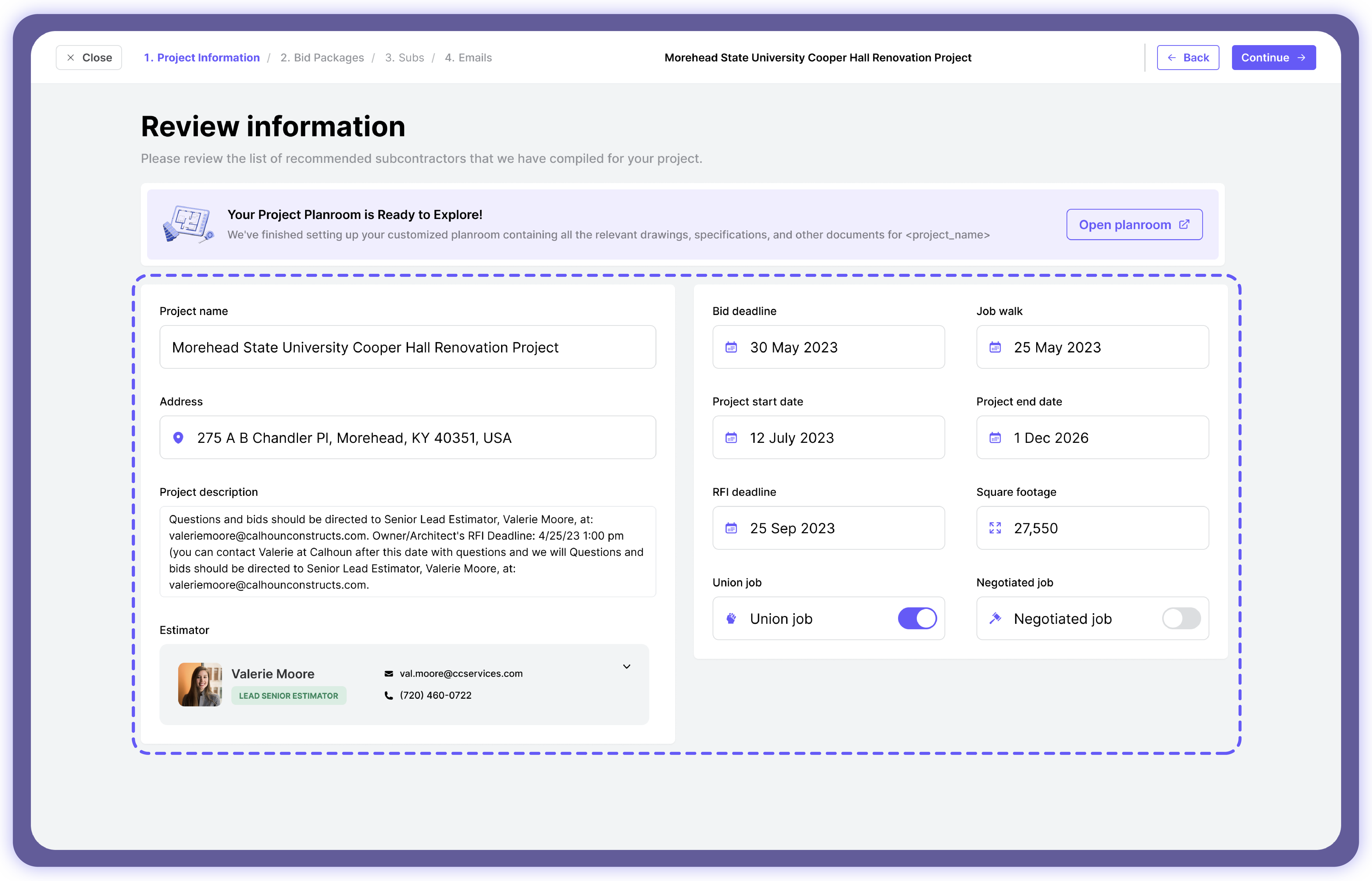
After successfully uploading the plans, the software immediately scans them to detect scopes. The process takes between 10 and 30 minutes, depending on the project’s complexity. You’ll receive an email once the process is completed.
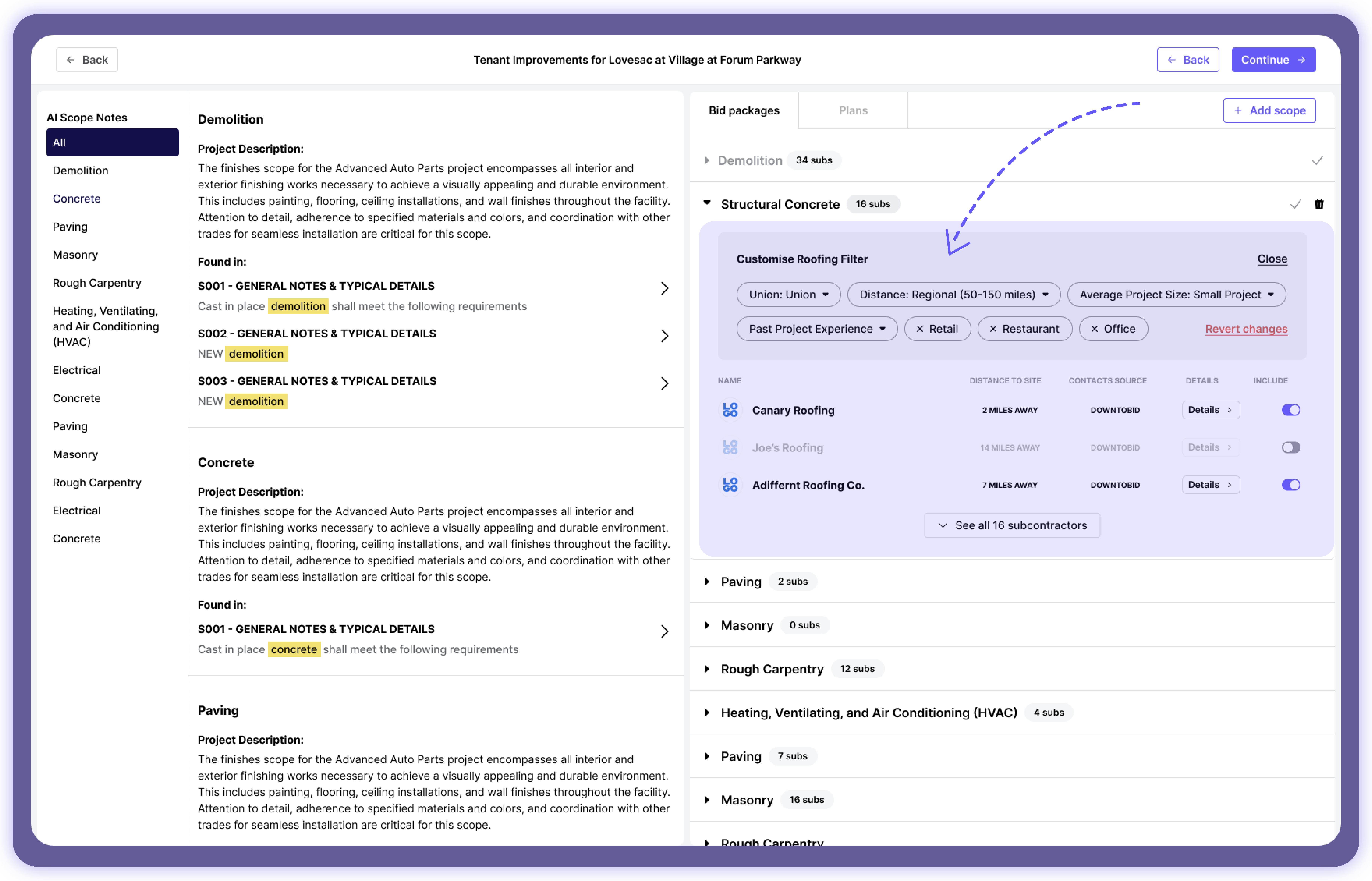
You'll receive a:
- A brief description of what’s inside every bid package.
- Plan sections where the scope was detected.
- A list of recommended local subcontractors matching project requirements.
The software breaks down the scope to help the estimating team create accurate estimates, eliminating the need for a stand-alone estimating software.
Downtobid then creates a suggested bid schedule to help you contact the right subs for the project. It suggests the period when subcontractors are active to trigger their response and improve bid participation. The follow-ups help general contractors contact subs who haven’t responded to invites. They’re spaced to avoid overwhelming trade partners or ending up in the spam folder.
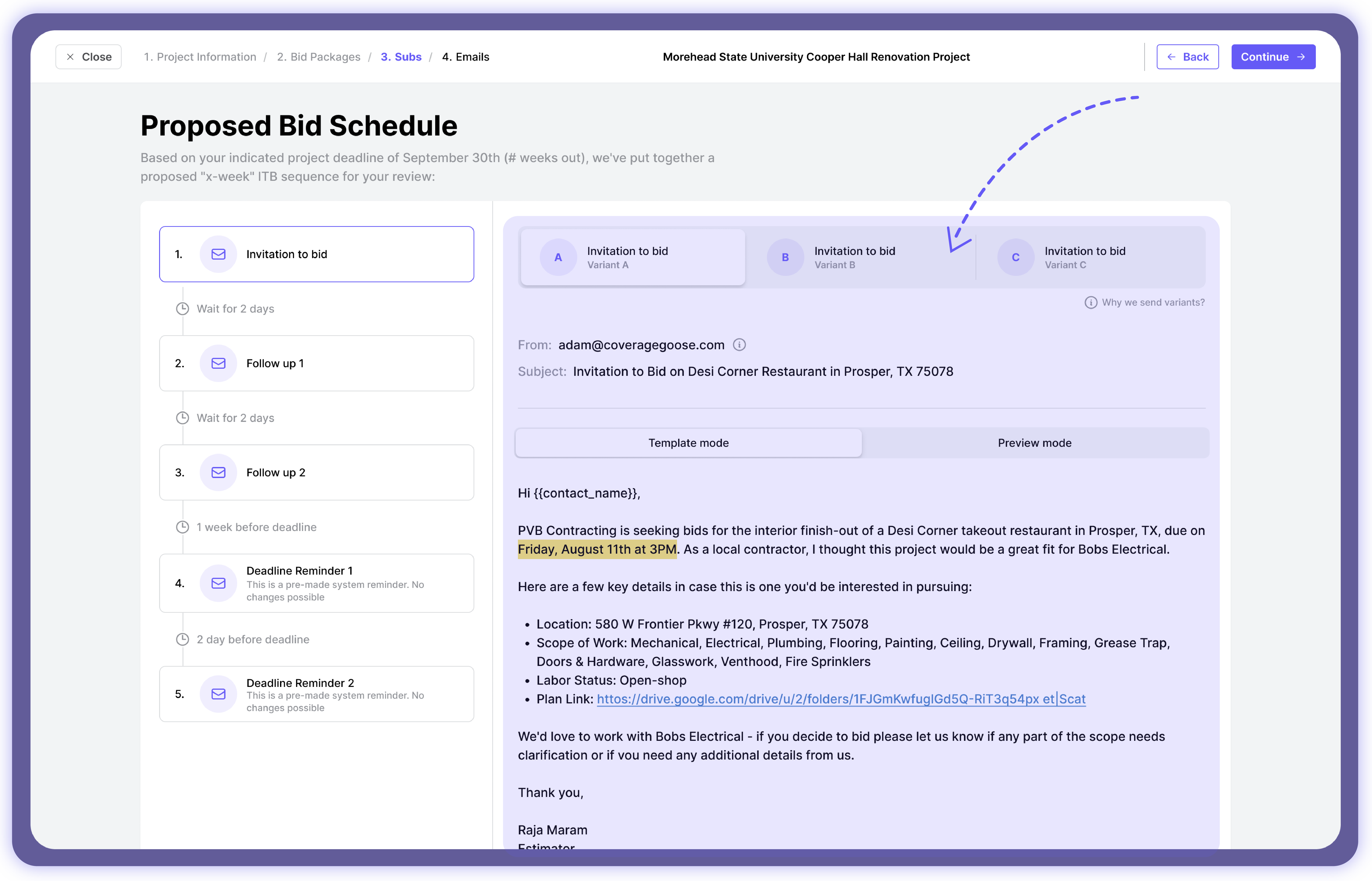
The tool has a sub-centric planroom to help subcontractors access construction plans and detect opportunities.
You can filter subs by how interested they are and their responses.
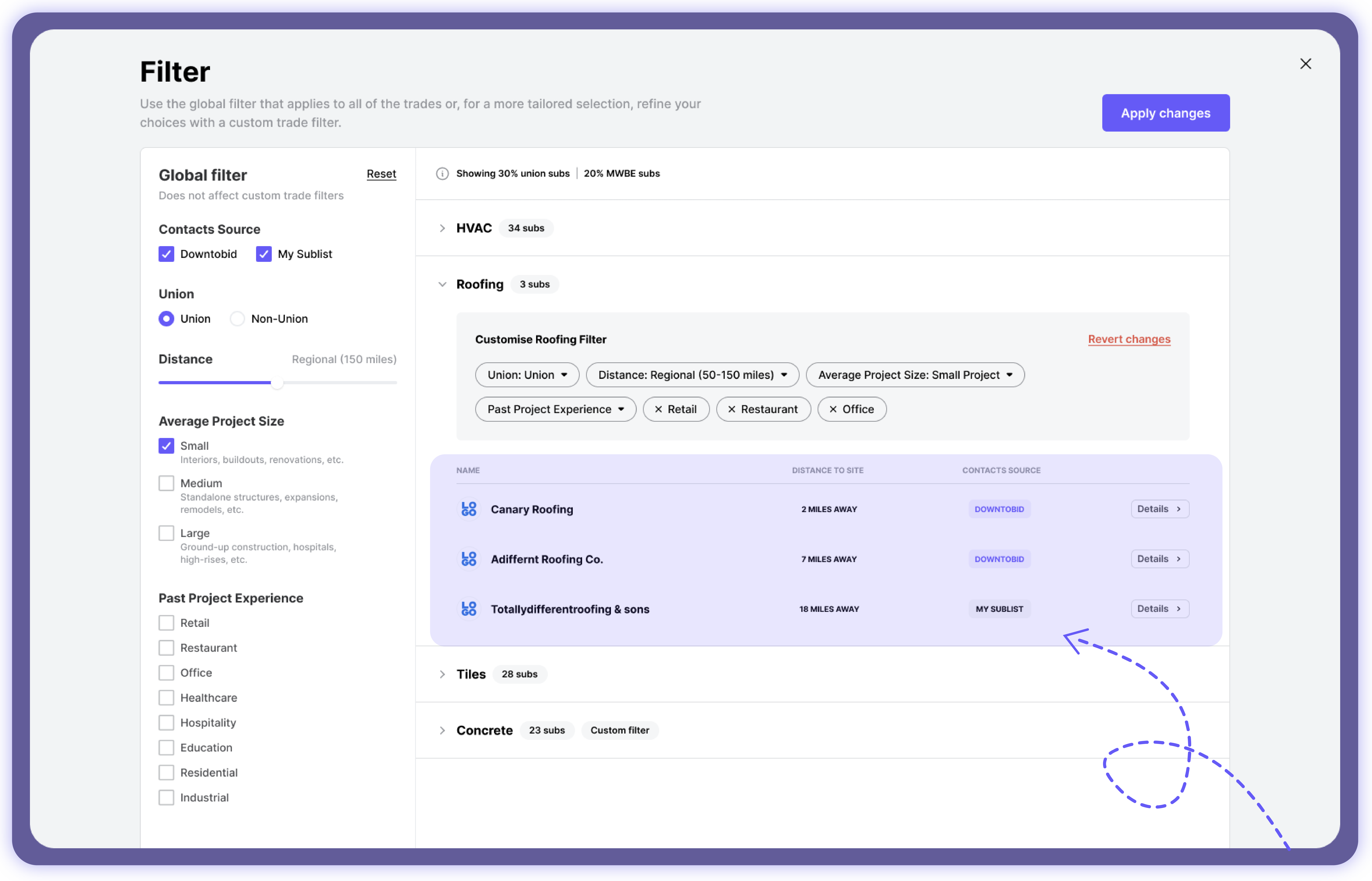
They can review specific documents without reviewing lengthy construction plans. They can access the planroom without creating an account.
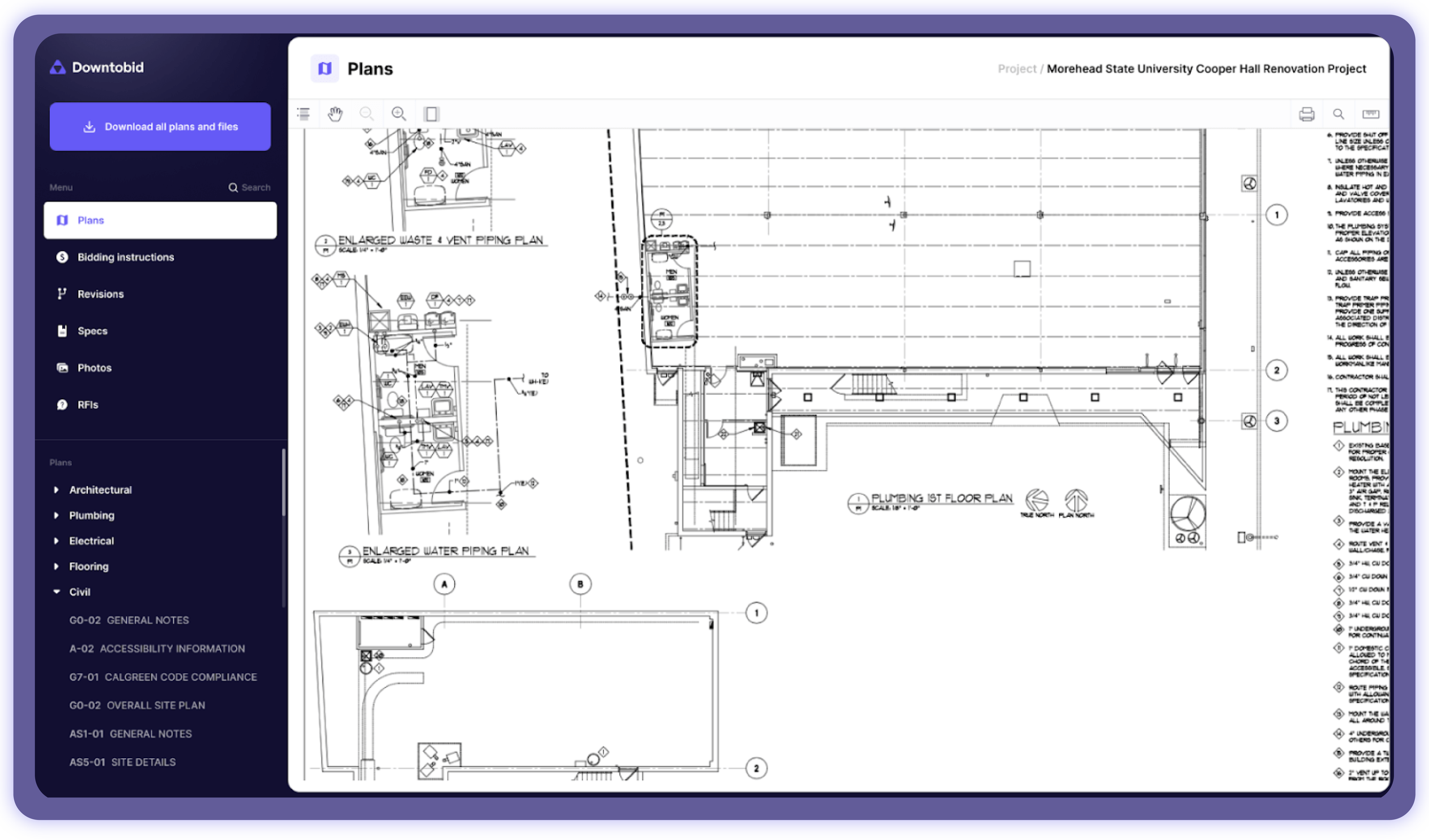
Centralized communication improves collaboration, helping the construction team send and receive real-time updates and feedback. You can also tag other team members, such as legal professionals to help in case of any problems. You don’t need to use an email app to review and respond to emails.
Final Thoughts
Recruiting the right subcontractors speeds up collaboration and helps achieve the project’s objectives. Downtobid Network is a clear winner against the Blue book network, providing verified subs and bid management tools. Think of it as an all-in-one construction bid management platform improving the commercial construction industry. Try our software today and put the power of automation in your hands.
Sources:
- Anyone have reviews on The Blue Book Network? : r/Contractor
- bluebook or other resources : r/estimators
- Anyone have reviews on The Blue Book Network? : r/Contractor
- Anyone have reviews on The Blue Book Network? : r/Contractor
- bluebook or other resources : r/estimators